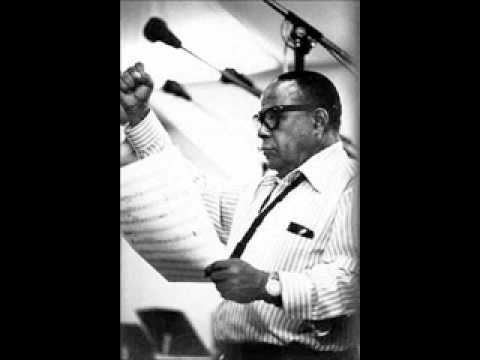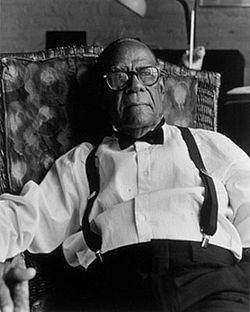Birth name Mario Bauza Cardenas Role Musician Years active 1925–1993 | Name Mario Bauza | |
 | ||
Born April 28, 1911La Habana, Cuba ( 1911-04-28 ) Occupation(s) Musician, arranger, composer Instruments Clarinet, saxophone, trumpet Died July 11, 1993, New York City, New York, United States Albums My Time Is Now, The Original Cuarteto Machin, 944 Columbus, Tanga, Afro-Cuban Jazz Similar People | ||
Mario bauz chucho
Mario Bauzá (April 28, 1911 – July 11, 1993) was a Afro-Cuban jazz musician. He was one of the first to introduce Latin music to the United States by bringing Cuban musical styles to the New York City jazz scene. While Cuban bands had popular jazz tunes in their repertoire for years, Bauzá's composition "Tangá" was the first piece to blend jazz with clave, and is considered the first true Afro-Cuban jazz or Latin jazz tune.
Contents
- Mario bauz chucho
- Mario bauza his afro cuban jazz orchestra leverkusener jazztage 1992
- Biography
- Tang and the creation of Latin jazz
- Master of arranging in clave
- Discography
- Songs
- References

Mario bauza his afro cuban jazz orchestra leverkusener jazztage 1992
Biography
Trained as a classical musician, he was a clarinetist in the Havana Philharmonic Orchestra by the age of nine, where he would stay for three years. Bauzá traveled to New York in 1925 to record with Maestro Antonio María Romeu's band, a charanga, shortly after his fourteenth birthday.

Bauzá had been hired as lead trumpeter and musical director for Chick Webb's Orchestra by 1933, and it was during his time with Webb that Bauzá both met fellow trumpeter Dizzy Gillespie and discovered and brought into the band singer Ella Fitzgerald. Importantly, Bauzá introduced the young Havana virtuoso Chano Pozo to Dizzy, when the latter wanted to add a Cuban percussionist to his band; though Pozo was killed in a Harlem bar fight just a year later, he left an indelible and long-lasting mark on Dizzy's playing and compositions, co-writing several legendary compositions such as "Manteca" and "Tin Tin Deo".

In 1938 Bauzá joined Cab Calloway's band, later convincing Calloway to hire Dizzy Gillespie as well. Bauzá continued to work with Gillespie for several years after he left Calloway's band in 1940. The fusion of Bauzá's Cuban musical heritage and Gillespie's bebop culminated in the development of cubop, one of the first forms of Latin jazz.

In 1941, Bauzá became musical director of Machito and his Afro-Cubans, a band led by his brother-in-law Machito. The band produced its first recording for Decca in 1941, and in 1942 Bauzá brought in a young timbalero named Tito Puente.

"Cubop City" and "Mambo Inn" followed the success of "Tanga." Machito and his Afro-Cubans often played straight-ahead big band mambo music. Many of the numbers were covers of recordings which had proved popular in Cuba. The band played mambo-style dance numbers at venues such as Manhattan's Palladium Ballroom. Bauzá kept his post as director of the Afro-Cubans until 1976. After this he worked sparingly, but was always highly respected. He recorded a few Cuban jazz albums which had limited sales. His last band made a guest appearance on a 1992 episode of The Cosby Show.
"Tangá" and the creation of Latin jazz
The band had a major hit with "Tangá," initially a descarga (Cuban jam) with jazz soloists, spontaneously composed by Bauzá. "Tangá", which was over time arranged with more complexity, is generally considered the first true Latin jazz or Afro-Cuban jazz tune.
The first descarga [Cuban jam session] that made the world take notice is traced to a Machito rehearsal on May 29, 1943, at the Park Palace Ballroom, at 110th Street and 5th Avenue. At this time, Machito was at Fort Dix (New Jersey) in his fourth week of basic training. The day before at La Conga Club, Mario Bauza, Machito's trumpeter and music director, heard pianist Luis Varona and bassist Julio Andino play something which would serve as a permanent sign off (end the dance) tune.
On this Monday evening, Dr. Bauza leaned over the piano and instructed Varona to play the same piano vamp he did the night before. Varona's left hand began the introduction of Gilberto Valdes' El Botellero. Bauza then instructed Julio Andino what to play; then the saxes; then the trumpets. The broken chord sounds soon began to take shape into an Afro-Cuban jazzed up melody. Gene Johnson's alto sax then emitted oriental-like jazz phrases. By accident, Afro-Cuban jazz was invented when Bauza composed "Tanga" (African word for marijuana) that evening.
Thereafter, whenever "Tangá" was played, it sounded different, depending on a soloist's individuality. In August, 1948, when trumpeter Howard McGhee soloed with Machito's orchestra at the Apollo Theatre, his ad-libs to "Tangá" resulted in "Cu-Bop City," a tune which was recorded by Roost Records months later. The jams which took place at the Royal Roots, Bop City and Birdland between 1948 and 1949, when Howard McGhee, tenor saxophonist Brew Moore, Charlie Parker and Dizzy Gillespie sat in with the Machito orchestra, were unrehearsed, uninhibited, unheard of before jam sessions which at the time, master of ceremonies Symphony Sid called Afro-Cuban jazz.
The Jazz SceneThe right hand of the "Tangá" piano guajeo is in the style known as ponchando, a type of non-arpeggiated guajeo using block chords. The sequence of attack-points is emphasized, rather than a sequence of different pitches. As a form of accompaniment it can be played in a strictly repetitive fashion or as a varied motif akin to jazz comping. The following example is in the style of a 1949 recording by Machito. 2‐3 clave, piano by René Hernández.
With "Tangá," Bauzá was the first to explore modal harmony (a concept explored much later by Miles Davis and Gil Evans) from a jazz arranging perspective. Of note is the sheet of sound effect in the arrangement through the use of multiple layering. Under Bauzá's direction, Machito and his Afro-Cubans were first band to successfully wed jazz big band arranging techniques within an original composition with jazz oriented soloists utilizing an authentic Afro-Cuban-based rhythm section in a successful manner. e.g. Gene Johnson – alto, Brew Moore – tenor, composition in "Tanga" (1943).
Master of arranging in-clave
The 3-2/2-3 clave concept and terminology was developed in New York City during the 1940s by Bauza while he was the music director of Machito and his Afro-Cubans. Bauzá was a master at moving the song from one side of clave to the other. The following melodic excerpt is taken from the opening verses of “Que vengan los rumberos” by Machito and his Afro-Cubans. Notice how the melody goes from one side of clave to the other and then back again. A measure of 2/4 moves the chord progression from the two-side (2–3), to the three-side (3–2). Later, another measure of 2/4 moves the start of the chord progression back to two-side (2–3).
The first 4 1⁄2 claves of the verses are in 2–3. Following the measure of 2/4 (half clave) the song flips to the three-side. It continues in 3-2 on the V7 chord for 4 1⁄2 claves. The second measure of 2/4 flips the song back to the two-side and the I chord.
In songs like “Que vengan los rumberos,” the phrases continually alternate between a 3–2 framework and a 2–3 framework. It takes a certain amount of flexibility to repeatedly reorder your orientation in this way. The most challenging moments are the truncations and other transitional phrases where you “pivot” in order to move your point of reference from one side of clave to the other.
Bobby Sanabria, who was Bauzá's drummer during his later years, points out that Bauzá was the first to explore jazz arranging techniques with authentic Afro-Cuban rhythms on a consistent basis giving, it a unique identifiable sound that no other band in the genre of Afro-Cuban-based dance music had at the time. Cuban big band arranger Chico O'Farill stated: "This was a new concept in interpretating Cuban music with as much (harmonic) richness as possible. You have to understand how important this was. It made every other band that came after, followers."
Discography
Songs
Mambo Inn
Chucho
Azulito
